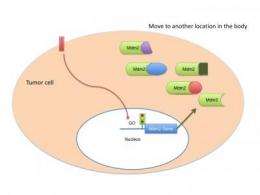New understanding of how to prevent destruction of a tumor suppressor

Researchers from the Indiana University School of Medicine and colleagues at the University of Texas Southwestern and Case Western University have determined how the protein Mdm2, which is elevated in late-stage cancers, disables genes that suppress the growth of tumors. The finding may lead to the development of new drugs for late stage breast cancer and other difficult to treat malignancies.
The investigators have identified a critical pathway that stimulates the production of Mdm2 causing an increase in the level of protein that bind to p53, the most common tumor suppressor, as well as other tumor suppressors, and extinguishes tumor suppression activity. The study appears in the January 2010 issue of the Journal of Clinical Investigation.
Principal investigator Lindsey Mayo, Ph.D., assistant professor of pediatrics at the Herman B Wells Center for Pediatric Research at the IU School of Medicine and an Indiana University Melvin and Bren Simon Cancer Center member, says that keeping Mdm2 inactive and preventing the destruction of the tumor suppressor that Mdm2 targets, is critical to preventing cancer from spreading within the body.
To explain the role of Mdm2 and how the newly identified pathways function, Dr. Mayo uses the analogy of a florescent ceiling fixture in which Mdm2 is the fluorescent bulb. "Initially, it was only known that the light was on, not how it was turned on. We discovered the wall switch and wires that connect to the light fixture to turn on the fluorescent light."
"This work provides new evidence about an important mechanism that tumor cells use to promote metastasis. While it has long been known that the loss of tumor suppressor activity triggers cancer, knowledge of how these cancer inhibitors are turned on and off has eluded researchers. Understanding the signaling pathways that elevate Mdm2 is critical to preventing cancer from spreading within the body and key to attacking many late stage cancers," said Dr. Mayo, a molecular biochemist who studies the mechanisms that control tumor suppressors.
While it is too early to speculate on which chemical compounds may yield successful drugs, Dr. Mayo says this new insight into Mdm2 and its pathways provides a useful roadmap to stimulate development of new compounds which could bind to Mdm2 to inhibit the protein and stop its attacks on tumor suppressors.
More information: TGFβ1 induced expression of Hdm2 correlates with late stage metastatic breast cancer. Journal of Clinical Investigation. 120 (1):1-14 (2010)
Source: Indiana University School of Medicine













